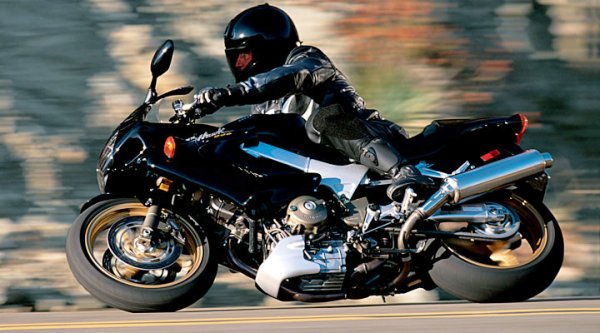
At MD, we do our best to bring you the latest and greatest from every significant motorcycle manufacturer, often beating our competitors to press with ride reviews and reports. At the same time, we try to keep our feet on the ground and report on bikes we think our readers might be interested in . . . even those bikes with a long shelf life.
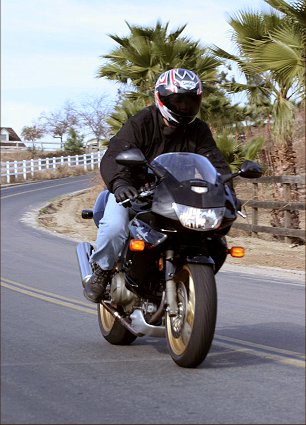
One of the real-world motorcycles often overlooked on the showroom floor is the Honda Super Hawk. It has been around with very few changes since it was introduced in 1997. It was one of the first Japanese v-twins to take on Ducati (Suzuki introduced its TL1000S at virtually the same time). As such, it was highly anticipated by the motorcycling press, and consumers, alike.
The Super Hawk represents one of the first efforts by Honda to isolate rear wheel suspension forces, and swingarm forces from the steering head by pivoting the swing arm directly through the engine cases. Thus, the Super Hawk frame visibly stops before reaching the swing arm pivot point.
All of this was part of a “tuned flex” approach Honda took towards chassis design with the Super Hawk, recognizing that some chassis flex was necessary to deal with tire impacts that could not be handled efficiently by a conventional suspension system (such as bumps mid-corner with the bike significantly leaned over).
The v-twin engine design is a 90° lay out — effectively eliminating primary balance issues. It is also carbureted, rather than fuel injected, and Honda did a good job of setting up the carbs from the beginning.
With 996cc, and a six-speed transmission, the Super Hawk is meant to have ample torque available for any circumstance. Although the bore and stroke of the engine is substantially over-square (large bore and short stroke), a low 9.4-to-1 compression ratio, and softish cams help create a broad, smooth power band intended for spirited street riding, but not racing (the Honda racing v-twin was later introduced as the RC51 — with a different motor).
Suspension consists of a 41mm cartridge fork in front (adjustable for preload and rebound damping) and a single shock in the rear (also adjustable for spring preload and rebound). Brakes include dual 296mm discs, and four-piston calipers up front, with a single 222mm disc (and single piston caliper) out back.
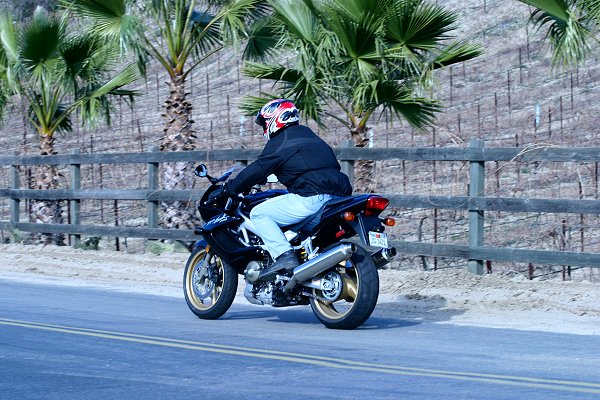
At a claimed 426 pounds dry, the Super Hawk is reasonably light for a street-going v-twin (lighter than a Ducati 916 superbike, when it was introduced). The bike is relatively slim, and has a 4.2 gallon gas tank capacity.
For 2004, the Super Hawk has one option as far as paint and graphics. That is, black paint with gold wheels (as pictured). The bike has a sporty look, without the super-aggressive ergos of some of the Italian competition.
Like any carbureted bike, the Super Hawk benefits from some warm up, but the carburetors are dialed in well enough that it pulls away smoothly, and without too much clutch slipping.
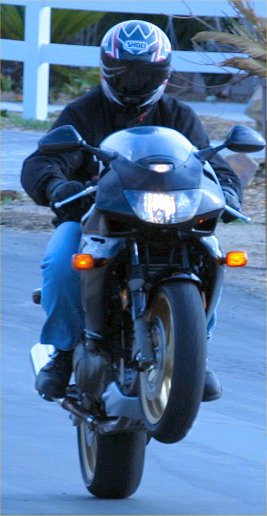
The Super Hawk likes to run below 7,000 rpm, where it has a broad, torquey pull, and relatively smooth throttle response. Let revs fall below 3,000 rpm, however, and the bike’s drive-train can feel a bit snatchy.
The hydraulic clutch is smooth and predictable, with a bit of a heavy pull. The transmission is very smooth and positive for a large displacement v-twin.
The Super Hawk handles very well, and predictably, up to a sane street pace. If you try to push this bike into the super sport handling category, chassis flex becomes noticeable and, in general, the Super Hawk protests. Ride it like a typical sport tourer, however, and the Super Hawk does virtually everything you ask of it in its smooth, Honda style.
The suspension is set up well by Honda for the Super Hawk’s intended purpose. It is relatively plush, but firm enough to allow for some spirited riding if you don’t get carried away (see comments above). We found rebound damping a little bit slow, as set by the manufacturer. Fortunately, the shock and the fork provide rebound damping adjustment, and we were ultimately able to set up both ends satisfactorily (we went all the way out on the fork’s rebound damping adjustment). Heavier riders will benefit by bumping up spring preload on the shock one or two notches. The Super Hawk is a comfortable street mount. Far more relaxed, ergonomically, than the super sport machines, although it is perhaps a bit more aggressive than many sport tourers. The reach to the bars is a bit of a stretch, but the bike proved comfortable overall, with the shape of the small tank and the seat complimenting the rider triangle (bar/peg/seat relationship). Longer trips in the saddle proved the seat can ultimately feel a bit hard, and commuters and tourers might benefit from an after-market seat.
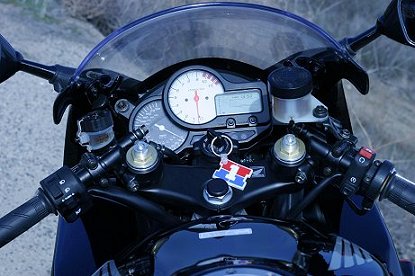
Instrumentation is fine, but the speedometer (which registers all the way to 180 miles per hour — even though the bike tops out at 140, or so) is too crowded (not enough space between the different speeds indicated). The fuel gauge proved pretty accurate, but the low fuel indicator isn’t the easiest to read, and this could prove important with the relatively short range offered by the 4.2 gallon tank (the bike returned 32 to 38 miles per gallon during our testing).
Brakes worked well, but didn’t provide the greatest feed-back (particularly, the front brake). Owners might do well to swap out the stock lines for braided steel.
Night vision with the headlight was adequate, but not in the same league with the modern, multi-reflector designs available on many other machines.
The Super Hawk offers decent wind protection from its bikini fairing, and proved to be a fun mount in a variety of street riding conditions. Aside from everything else, it offers that endearing character that 90° v-twins all seem to have. There is something about the loping power delivery, coupled with the intake and exhaust noises from bikes like the Super Hawk that lead many owners to form a more personal bond with their machines. There are also plenty of parts available now to customize a Super Hawk, including exhaust systems, jet kits, optional windshields, brakes, etc.
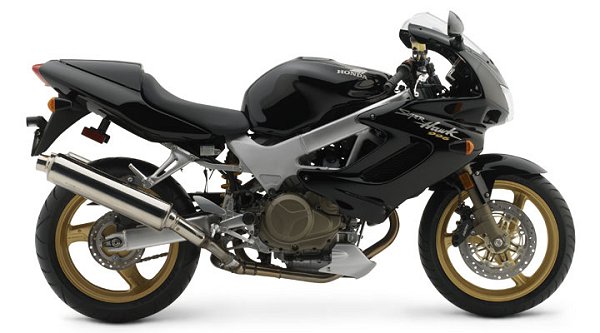
In a world where every manufacturer seems to be in a mad rush to provide gross overkill to the customer in terms of acceleration, braking and handling, the Super Hawk sits quietly on the dealer’s showroom floor without attracting much attention. It is nevertheless a better choice for many customers that end up with a super sport. U.S. MSRP of the 2004 Honda Super Hawk is $8,999. If you have any bargaining skills, whatsoever, you shouldn’t pay anywhere near this price in the United States, however.





